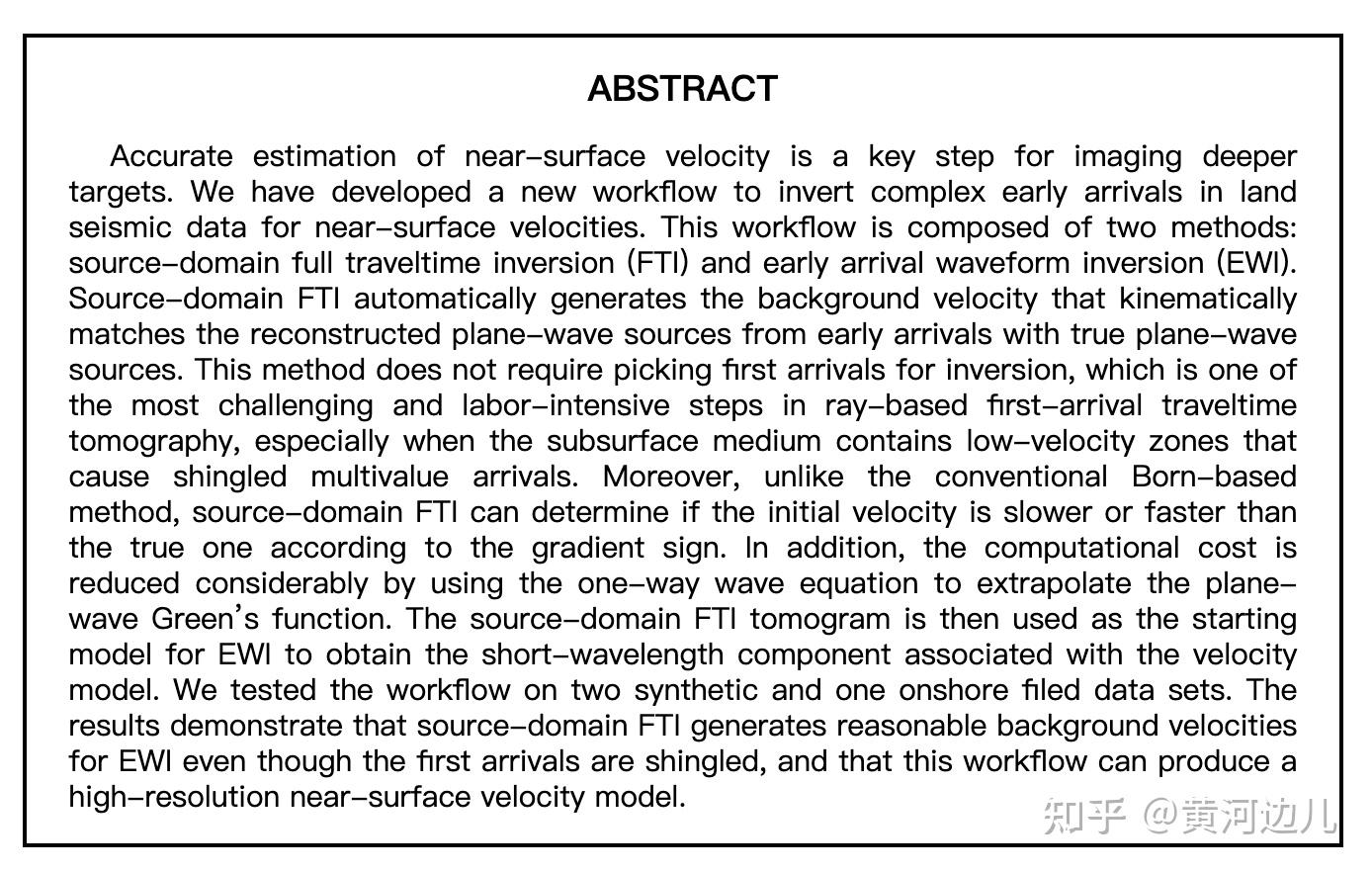我以我的一篇文章为例, 介绍下摘要的写法.
这篇文章发表在地球物理勘探领域的顶刊 Geophysics, 在2018年被提名为了年度最佳论文, 并且被选为亮点文章. Geophysics一般一年刊出430篇文章左右, 每年只会选四篇文章获奖. 所以, 这篇文章可能是一个比较好的例子, 来介绍如何写一个不错的学术文章摘要.

文章摘要部分:

首先, 摘要的第一句话, 用于简明扼要的介绍下研究领域的背景, 这篇文章做的是利用地震数据进行近地表速度的建模, 所以, 我是这么写的:
“Accurate estimation of near-surface velocity is a key step for imaging deeper targets.”,
交代了研究近地表速度的重要性.
第二, 一句话简述方法干了什么.通常这句话, 要切合第一句话, 相当于, 有面到点, 第一句话, 介绍研究领域(面), 第二句话介绍在该研究领域下你的方法做了什么事儿. 我这里这么写的:
We have developed a new workflow to invert complex early arrivals in land seismic data for near-surface velocities.
第三, 然后就可以介绍下方法的流程, 新的发现, 新的成果, 方法内容等, 这里是摘要的关键. 通常, 科技论文方法都会比较复杂, 很难在一两句话里说清楚, 有些作者会写很长的句子, 其实不便于阅读. 所以为了更好的可读性, 我的经验是, 拆分! 首先指出总体方法有哪些技术构成, 比如我这里写的是:
”This workflow is composed of two methods: source-domain full traveltime inversion (FTI) and early arrival waveform inversion (EWI)“.
由此说明了我的总流程主题有两个方法组成, 然后就可以在后面分开介绍这两个方法, 介绍的时候, 本着 先介绍方法作用 + 方法创新 的形式写. 比如, 这里首先介绍方法一的作用:
“Source-domain FTI automatically generates the background velocity that kinematically matches the reconstructed plane-wave sources from early arrivals with true plane-wave sources. ”
紧接着, 再介绍方法一的新特点, 新的创新, 即:
“This method does not require picking first arrivals for inversion, which is one of the most challenging and labor-intensive steps in ray-based first-arrival traveltime tomography, especially when the subsurface medium contains low-velocity zones that cause shingled multivalue arrivals. Moreover, unlike the conventional Born-based method, source-domain FTI can determine if the initial velocity is slower or faster than the true one according to the gradient sign. In addition, the computational cost is reduced considerably by using the one-way wave equation to extrapolate the plane-wave Green’s function. ”
然后介绍方法二的作用和创新点, 我这里写:
“The source-domain FTI tomogram is then used as the starting model for EWI to obtain the short-wavelength component associated with the velocity model.”,
我这篇文章的主要创新点在方法一, 所以在写方法二的时候, 可以只介绍方法二的作用.
第四, 介绍该方法都做了哪些重要的测试和验证. 比如我这里写:
“ We tested the workflow on two synthetic and one onshore filed data sets. ”
最后, 阐明论文的结论. 比如我这里写:
“The results demonstrate that source-domain FTI generates reasonable background velocities for EWI even though the first arrivals are shingled, and that this workflow can produce a high-resolution near-surface velocity model.”
值得一提的是, 至于提供对研究结果的讨论或者未来工作的展望等等, 不要放在摘要里, 可以在文中的discussions部分阐明. 另外, 摘要里切不可出现引文. 再有, 除了第一句话以外, 摘要里的其他内容要尽量避免出现本研究领域的常识类的信息.
我是
搞了14年科研,依然在路上, 欢迎点赞关注我, 交流日常科研生活.